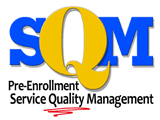“We need more enrollments,” says the college president or chief financial officer or take your pick. No problem, you may be thinking, in light of the fact that tuition has been raised – again – and there are areas of the institution that are in need of let’s say “enhancement in quality.” What’s an enrollment manager to do? Information from our recent national study provides the answer.
 The perceived value that a student attaches to your institution correlates strongly with his or her likelihood of enrollment. Perceived value has three components: perceived quality, cost and excitement about attending. A change in any one will impact your total perceived value score which, in turn, impacts enrollment.
The perceived value that a student attaches to your institution correlates strongly with his or her likelihood of enrollment. Perceived value has three components: perceived quality, cost and excitement about attending. A change in any one will impact your total perceived value score which, in turn, impacts enrollment.
The perceived quality of a college may be more or less important from student to student although it may be safely assumed that it is universally important. Cost is also important. These two factors, however, do not have as strong an influence on enrollment as does the student’s excitement about attending the college. Students may find colleges of higher perceived quality and lower cost than others under consideration but if their level of excitement about attending is low then they are significantly less likely to enroll.
Of the three components, cost is likely to be the hardest for a college to change. Its published sticker price may be flexible through discounting but in all likelihood tuition will continue to rise.
Real and perceived qualities are changeable. However, both take time, require internal collaboration, and demand adequate resources.
The single component in the value score that is most flexible and impacting on enrollment growth is student excitement about attending. It is more strongly correlated to enrollment – by a factor of two – than either cost or perceived quality. This was one of several surprising findings revealed in Longmire and Company’s latest nationally co-sponsored study, “Your Value Proposition: How prospective students and parents perceive and select colleges.” Click here to download a copy of the report.
Generating excitement is a multi-dimensional process and should involve everyone on campus. It may entail building and communicating a brand that attracts individuals with similar interests, putting students in the company of others with similar passions, providing opportunities to work closely with faculty, offering prompt and attentive customer service, having a unique energy and atmosphere on campus, and any number of other attributes that strike an emotional chord with a student and parent.
Creating excitement is in the wheelhouse (or should be) of the admission office and admission counselors. However, many people working in admissions don’t know how to create the level of excitement that it takes to win an emotional commitment from the student that will lead to enrollment. This problem usually arises because the department or counselor spends too much time selling the institution rather than trying to understand what the student sees and feels as being valuable.
The answer to increasing enrollment in the face of tuition and quality challenges lies in taking an entirely student-centric approach to recruiting where the admission office and counselors realize that “it’s not about the institution – it’s about the student.” This is powerful when put into practice. Through our Interactive Training Workshops for counselors, we spend a great deal of time changing the focus of admission counselors. We see their transformation and improvements in productivity. Most importantly, we see changes in the recruiting process that exposes students to the information and experiences that truly interest and excite them.
 Share the findings from your baseline customer service delivery measurements, and also your clearly articulated goals, with everyone on campus. That means administrators, faculty, groundskeepers, the school mascot, everyone. Each and every person at your institution will have a role in making prospective students feel welcomed and wowed, so it’s key that they are all well-informed and apprised of the plan.
Share the findings from your baseline customer service delivery measurements, and also your clearly articulated goals, with everyone on campus. That means administrators, faculty, groundskeepers, the school mascot, everyone. Each and every person at your institution will have a role in making prospective students feel welcomed and wowed, so it’s key that they are all well-informed and apprised of the plan. Another payoff of including everyone in the master plan is greater cohesiveness and engagement within the school community. Working towards a common goal together will elicit the kind of infectious school spirit and pride that will make your college a desirable place to be.even though the prospects didn’t know that they were particularly visible, they felt that they had just experienced one of America’s most friendly and helpful campuses.
Another payoff of including everyone in the master plan is greater cohesiveness and engagement within the school community. Working towards a common goal together will elicit the kind of infectious school spirit and pride that will make your college a desirable place to be.even though the prospects didn’t know that they were particularly visible, they felt that they had just experienced one of America’s most friendly and helpful campuses. recognition email all can be used to acknowledge excellence in pre-enrollment service. This is another opportunity to utilize the power of social media to broadcast good works and kudos. Give every member of your school the opportunity to be a campus rock star, and they will embrace the challenge.
recognition email all can be used to acknowledge excellence in pre-enrollment service. This is another opportunity to utilize the power of social media to broadcast good works and kudos. Give every member of your school the opportunity to be a campus rock star, and they will embrace the challenge. Longmire and Company conducts pre-enrollment customer service surveys for colleges across the country. We are more than happy to share the nationally aggregated data we’ve collected and initiatives that colleges have successfully implemented to deliver improved customer service. Just give us a call at (913) 492-1265 or send us a request using our Contact Us page.
Longmire and Company conducts pre-enrollment customer service surveys for colleges across the country. We are more than happy to share the nationally aggregated data we’ve collected and initiatives that colleges have successfully implemented to deliver improved customer service. Just give us a call at (913) 492-1265 or send us a request using our Contact Us page. In the last post, we shed some light on the pre-enrollment service perception problem – the fact that colleges and universities are losing potential students due to poor service during the courtship phase. Our studies have revealed that multiple factors such as responsiveness, grounds, food, faculty and admissions personnel strongly shape a student’s overall opinion of the institution and ultimately influence their final decision of where to attend.
In the last post, we shed some light on the pre-enrollment service perception problem – the fact that colleges and universities are losing potential students due to poor service during the courtship phase. Our studies have revealed that multiple factors such as responsiveness, grounds, food, faculty and admissions personnel strongly shape a student’s overall opinion of the institution and ultimately influence their final decision of where to attend. Let’s go back to the car salesman example: Much like choosing a college, buying a car is an important decision, and a big investment. There are many dealerships to choose from, and aside from price, the purchase decision will be heavily influenced by the human interaction and overall experience that a customer receives when they walk through the door. Car salesmen and dealership owners know this, and the most successful shops invest in making the customer experience as positive as possible. They hire sales personnel who treat customers with respect and put them at ease. They ensure the grounds and waiting room are clean and comfortable. They offer beverages and send follow-up thank you notes. They adopt an overall attitude of helpfulness toward the customer. All of these seemingly small details contribute to establishing a sense of trust between the customer and the seller. And if something is off during the ‘browsing’ stage, there is little chance the customer will follow through to the ‘buying’ stage.
Let’s go back to the car salesman example: Much like choosing a college, buying a car is an important decision, and a big investment. There are many dealerships to choose from, and aside from price, the purchase decision will be heavily influenced by the human interaction and overall experience that a customer receives when they walk through the door. Car salesmen and dealership owners know this, and the most successful shops invest in making the customer experience as positive as possible. They hire sales personnel who treat customers with respect and put them at ease. They ensure the grounds and waiting room are clean and comfortable. They offer beverages and send follow-up thank you notes. They adopt an overall attitude of helpfulness toward the customer. All of these seemingly small details contribute to establishing a sense of trust between the customer and the seller. And if something is off during the ‘browsing’ stage, there is little chance the customer will follow through to the ‘buying’ stage.
